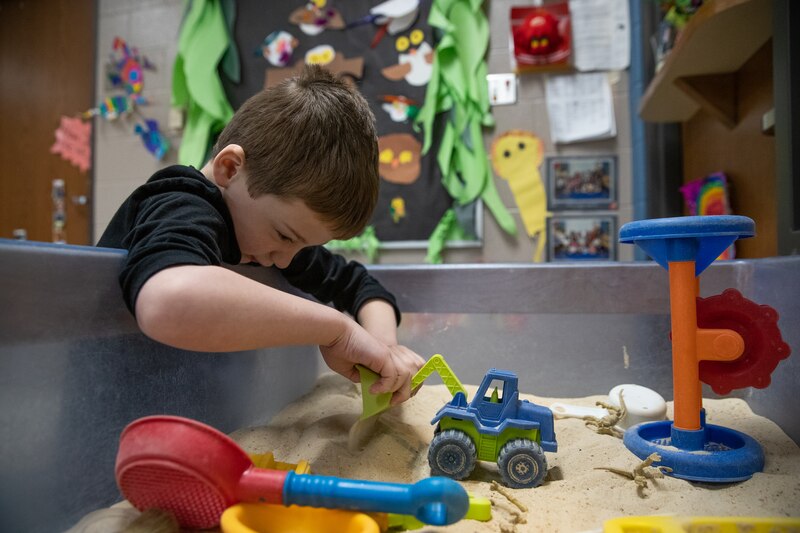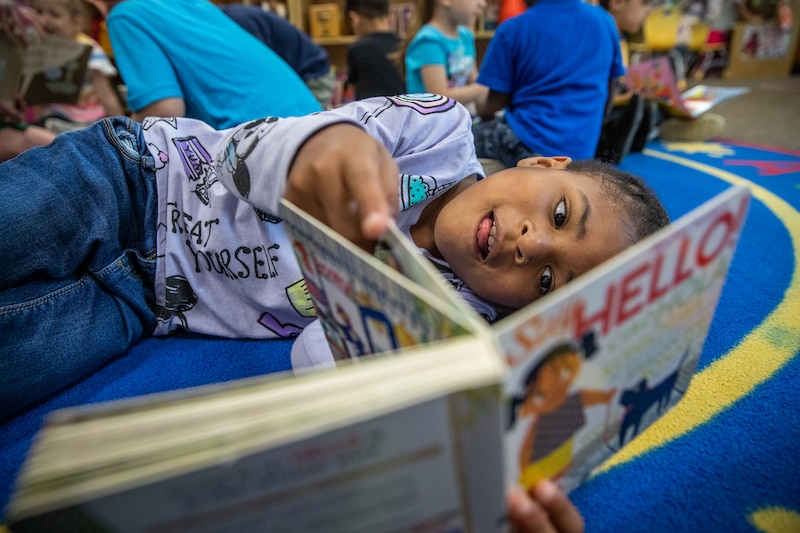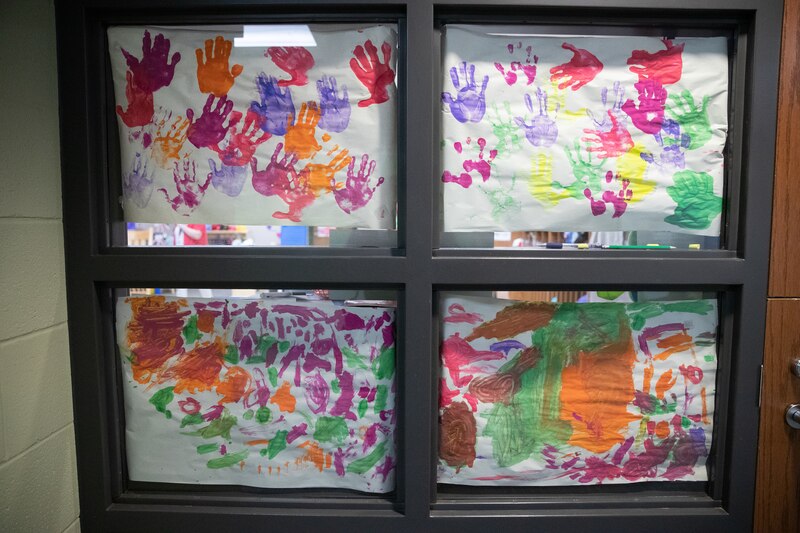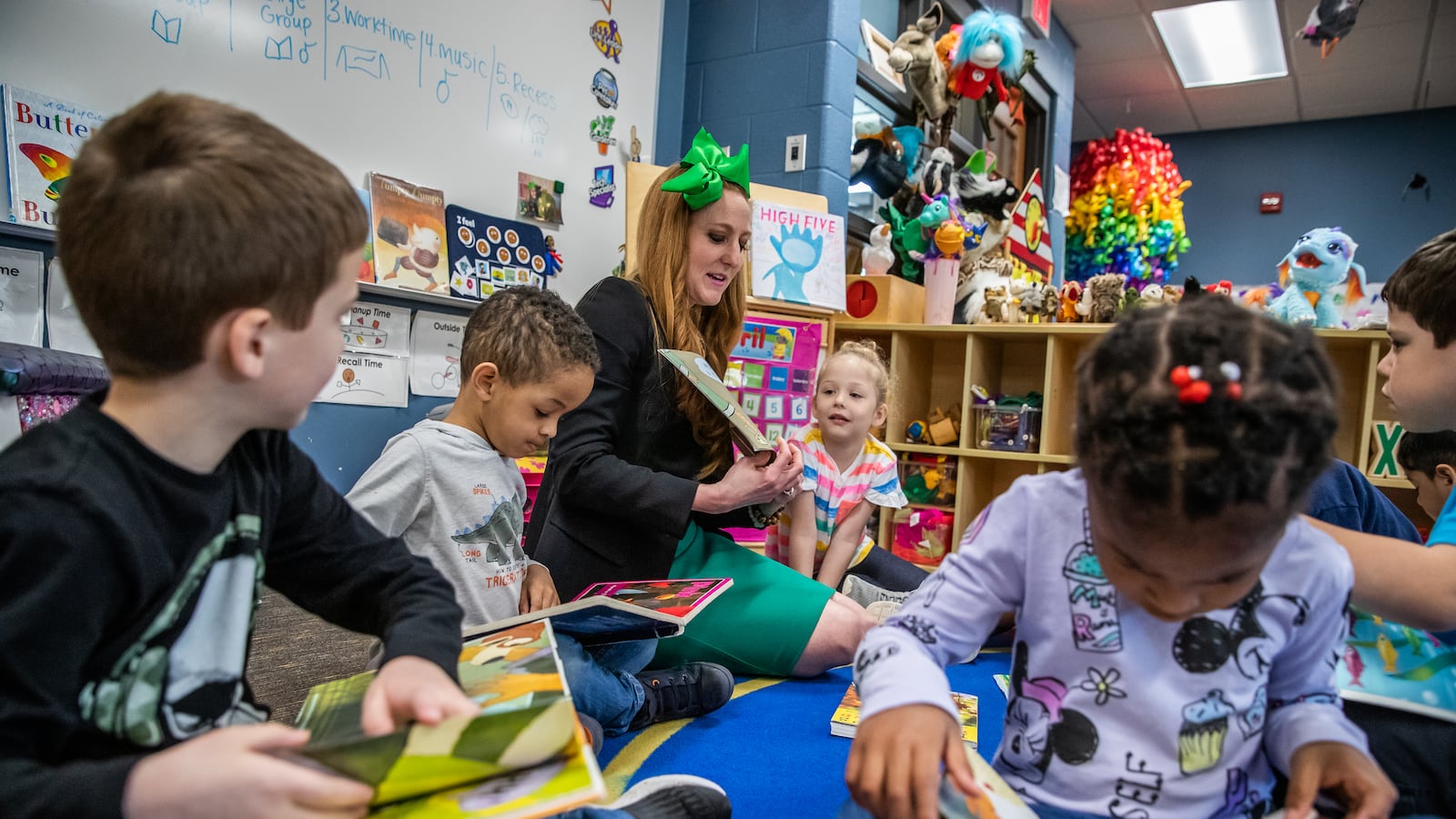When Allison Kempers calls out that it’s time to clean up, each 4-year-old in her Wayne Township Preschool classroom hops into action.
They return blocks and markers to their assigned buckets. Books go back in the shelf. A last-minute letter to the fairies is tucked into the mailbox near the inches-tall, glittery door on the classroom wall.
Then Kempers points to the next item on their daily schedule, written on the whiteboard. It’s time to read.
Most children grab a book and meet her on the large circular rug. One boy takes the opportunity for a quick bathroom break, stopping to wash his hands before joining his classmates.
Next year some of these children will be in Robin Johnson’s McClelland Elementary kindergarten classroom. And, as usual, she’ll know almost immediately who they are.
There will be fewer toys, but they will still hop into action when Johnson rings the bell and says it’s time to clean up, stuffing papers into the cubby labelled with their name. They’ll follow the schedule on the whiteboard and know how to go to the bathroom and wash their hands without help.
What Johnson knows also is reflected in the growing national body of research on preschool: students who attend preschool are more prepared for kindergarten. It repeatedly shows up in their literacy and math skills.
Johnson sees it when children know the correct way to hold a book, recognize their written names or follow directions when she asks them to put away their work and sit on the reading circle.
Where research disagrees is on whether this academic boost lasts after those students finish kindergarten, into third grade or even adulthood — a conversation that often comes up as states consider expanding to a state-funded universal preschool.
Indiana isn’t close to creating a universal program. Its young voucher program is income-based and serves only 1% of the estimated 4-year-olds who would qualify. Currently, there aren’t enough seats in high-quality programs to accommodate all 4-year-olds, and often the seats that do exist are too expensive.
But as lawmakers start to grapple with how much and how fast to invest in preschool, it deems fit to question: Should Indiana worry about research on long-term results to justify an expansion, or should it stay focused on getting children ready for kindergarten?

The argument for expanding preschool
Neuroscience has shown that ages 0-5 are critical years in brain development, setting the stage for the rest of a child’s life. They are key years to learn vocabulary, movement and how to learn.
“There’s a consensus in the field that the early childhood years are of critical importance vital to cognitive growth,” said Georgetown University professor Bill Gormley. “Profoundly important because learning occurs so rapidly.”
Some early childhood education advocates see this as the root of the argument for making sure every child has access to preschool. Research followed, looking to answer the question of whether going to preschool improves the rest of a child’s life.
A study of Tulsa, Oklahoma’s universal program in 2017 caught the attention of advocates and politicians when it found that some positive effects were discernible as late as middle school.
The students they studied were months ahead of their peers in reading, writing and math, said Gormley, one of the study’s authors. They were more likely to have higher standardized math scores in middle school, and more likely to enroll in honors classes. However, those children didn’t necessarily have higher grades or fewer suspensions.
This generally fell in line with two well-known, decades-long studies that followed children who went to experimental preschool programs in the 1960s and ’70s. They found the preschool alumni were more likely to hold a bachelor’s degree, hold a job and delay parenthood.
Critics question whether these results are still relevant today, saying it would be too costly to scale up the intense services provided to the small groups of students — as much as $20,000 per student. And the gap in learning between students who attend preschool and those who don’t is smaller now than in the 1960s because families are better informed and have more options, including professional childcare.
But success stories from both projects are still continuing.
New research from the Perry Preschool Project, whose participants are now between 50 and 55 years old, found that the children of people who went to preschool also reaped similar benefits.
Released in May, the newest Perry study found that 60% of participants’ children had never been suspended, addicted or arrested, compared to 40% of the control groups’ children.
Children of participants were also more likely to be employed full-time or self-employed.
In her experience as a kindergarten teacher, Johnson said students who went to preschool are more confident and independent, both socially and academically, which makes them more successful in her class. And the bar is set high — her kindergartners are now learning lessons she used to teach in first grade, like reading and writing complete sentences.
“If they’re successful in kindergarten, they’re probably going to be successful in first grade, second grade,” she said. “It’s just going to keep carrying on down the line.”
For decades this narrative was building, which is why it was so shocking last year when a study out of Tennessee found that students in its preschool saw negative long-term effects.

The argument against expanding preschool
Students in the Tennessee Voluntary Pre-K Program performed better than their peers at the end of preschool, the study found. But children who didn’t go to preschool caught up in kindergarten, the study said, and generally surpassed them.
The study found similar results in third grade — that the preschool alumni did not perform as well as the control group. School records showed “somewhat more disciplinary actions” for the preschool participants.
“This assumption started with Head Start back in 1964 was that … if we can bring poor children up to the same starting line, they should do well in school later on,” said Dale Farran, one of the Tennessee study’s authors. “That didn’t happen with us.”
Farran, a Vanderbilt University professor, said she wasn’t expecting the negative results, and is still trying to figure out what caused them. One option she considered is that adding another year of school and asking children to sit still and listen to a teacher could make them dislike school. Another is that the kindergarten teacher wasn’t building on the knowledge some students already had from preschool, but rather starting back from the beginning for everyone.
Whatever the reasons, the study has provided new ammunition for those who are reluctant to spend more taxpayer dollars on pre-school.
Rep. Chris Judy, a Republican who represents Fort Wayne, told IndyStar he doesn’t support allocating more dollars to preschool, referencing data on long-term results.
“From the data I had received it looked like by the time they got to third grade, whether you’re pre-K or not, it’s the same level,” he said.
Judy said the state should focus on funding K-12.
“We have a limited amount of money in our budget,” he said. “At least 50 percent of it goes to K-12. So my question is, where does it stop?”
Critics of the Tennessee study say it’s difficult to tie this success or failure back to preschool. There are too many variables that are impossible to rule out between kindergarten and third grade, multiple experts told IndyStar.
The results may speak more to the quality of the preschool, which can vary by classroom, or of the elementary school. For example, the students’ success in third grade could have been hindered by an ineffective second-grade teacher.
That makes studying long-term effects difficult in general, which is why some advocates argue the expectation for preschool should be limited to whether it prepares a student for kindergarten.

Where Indiana stands
The negative results of the Tennessee study didn’t cause the state to abandon preschool, said Laura Bornfreund, director of the nonpartisan think tank Early & Elementary Education Policy at New America.
Instead, she said the state doubled down and worked on improving the quality of its program, including by better training preschool teachers.
Tennessee’s program met seven of the National Institute for Early Education Research’s 10 quality requirements in 2018, including teachers having a bachelor’s degree and class sizes with 20 or fewer students. Oklahoma’s program met nine.
“What we don’t want to see in pre-K — that’s not OK — is kids sitting where the teacher is talking at them for extended periods of time,” Bornfreund said. “They shouldn’t be doing worksheets or sitting at tables for long stints of time. Research supports that.”
That’s something for Indiana to consider, she said.
“Indiana’s program isn’t yet what I would necessarily call a high-quality program,” Bornfreund said. “It has a lot of potential.”
Indiana’s state-funded voucher program, On My Way Pre-K, was not ranked by NIEER in 2018 because the eligibility requirements for parents disqualified it as a state-funded program by the national group’s standards.
On My Way Pre-K is too new to have any data on long-term effects. The students participating in the state’s study just finished second grade.
Sara Schmitt, one of the authors, said researchers plan to check in on the students again next year, when they are in third grade. Ideally, Schmitt said they would have the students take the same tests administered in preschool and kindergarten, but that isn’t in the budget. Instead, they will look at standardized test scores.
“It’s going to be hard to make any claims about that in Indiana because we won’t really have the direct assessment data to truly be able to talk about the gains that exist after the spring of kindergarten,” said Schmitt, an assistant professor at Purdue University.
The state’s 2018 report found that children who used On My Way Pre-K had stronger gains in language comprehension, literacy, math, self-regulation and school readiness. They were measured against children who were in child care programs that are “adequate” but not rated high-quality by the state.
“These measured differences are modest in magnitude, and it is not clear if they will persist beyond kindergarten,” the report said.
But the report doesn’t stop with students. It also attempts to measure the benefit for parents — results that are of interest to local employers, and, in part, drives support from Indiana businesses for expanding the state-funded program.
By surveying parents, researchers found that more than a quarter were able to get a job after their children received the On My Way Pre-K grant and started preschool. Half of the parents said they worked more hours.
Overall, authors concluded that having a quality and reliable place to send their children also improved the lives of their parents.
Denise Hill said she put her daughter, Michelle, in preschool because both she and her husband work. They didn’t have time to prepare her for preschool themselves, she said. They chose to live in Wayne Township because they heard the public school system was good.
Hill got her daughter on the wait list for Wayne Township Preschool when she was 3. Her daughter spent a year in a local church program before a spot opened up.
They didn’t qualify for On My Way Pre-K, so Hill said they paid about $150 a week.
“We wasn’t really prepared for it because, we didn’t think we were going to have to pay that much,” Hill said. “But we didn’t mind because it was for the education of our child.”
When it came time for her to go to Johnson’s kindergarten class, Hill said the transition was seamless. Other children in their extended family didn’t go to preschool, and Hill said she could tell the difference.
Aside from being more prepared, academically, the 4-year-old was ready to be away from her parents for an entire day.
Now finished with kindergarten, her daughter still loves to read. To Hill, that’s what is important.
MOVING 4WARD is a collaborative reporting project by IndyStar and Chalkbeat Indiana. The project will examine the current state of Early Childhood Education in Indiana with an emphasis on how best to prepare our state’s 4-year-olds (hence the project title) for kindergarten and beyond. Expect stories to take a critical look at preschool programs, issues of access to those programs, the debate over the value of taxpayer-funded universal preschool, what lessons can be learned from other states, and – perhaps most importantly – what you, as a parent, need to know to make informed decisions about choosing your child’s preschool.
Chalkbeat reporter Stephanie Wang and IndyStar photographer Mykal McEldowney contributed to this story.
Contact IndyStar reporter Emma Kate Fittes at 317-513-7854 or efittes@gannett.com. Follow her on Facebook and Twitter: @IndyEmmaKate

